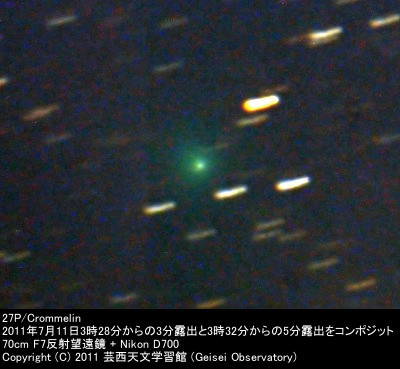In 1956, the year Comet Crommelin reappeared after a 28-year-absence,
Doctor Issei Yamamoto was spreading the word widely that aurorae could
be seen at mid-latitudes including Japan due to the Sun's increased activity.
Aurora-like bright nightglows were seen across the country, though they
were not real aurorae. In fact, when I got up at 2 in the morning to search
for Comet Crommelin, I found the night sky over Kochi was so bright that
it would be mistaken for a full-moon night. This phenomenon was also witnessed
at Yamamoto Observatory in Shiga prefecture.
The predicted path of Comet Crommelin was to go through looming
Leo rising in the pre-dawn eastern sky. Being aware of the inaccuracy of
the predictions, I searched in the usual way by moving from overhead gradually
down toward the eastern horizon. I saw many clusters and galaxies, but
as I had been well experienced in comet search by then, I ticked them off
as non-cometary objects at a glance. Then, when the 15cm reflector's eyepiece
field moved slightly to the north of the Lion's large sickle, a strange
light grazed the edge of the field and moved away. I immediately swung
back to center the object in the field. It's there! A suspicious comet-like
diffused hazy glow.
This was a totally unexpected visitor. "Is it Crommelin?"
My heart began pounding hard like rapidly ringing bells. Mr. Yamazaki's
face crossed my mind and Dr. Yamamoto's smiling face, too. They must have
been hoping for my discovery of the comet. The comet overlapping with their
faces glows brightly. "Send a telegram quickly!" I became very
anxious. From my memory there shouldn't be any comet wondering around that
area. "It must be Crommelin!" That mysterious 28-year period
comet had just returned! That morning, I sent a telegram, first to Tokyo
Astronomical Observatory, then to Yamamoto Observatory and to its discoverer
Mr. Masamitsu Yamazaki, who discovered it 28 years earlier and must have
been waiting for good news from me. The telegram was written in the coded
words peculiar to the astronomical community in line with the conventional
universal telegraph. The director of Tokyo Astronomical Observatory must
have been startled having received a comet discovery telegram from a nameless
observer in the countryside of Kochi. It was not an ordinary comet, they
must have thought, and passed it on to the main observatories and other
research institutes in Japan.
At the same time, an international telegram arrived from
Minor Planet Center in Copenhagen reporting the discovery of a new astronomical
object. It was a comet discovered in Czechoslovakia and its position was
identical with mine. Comet Crommelin was discovered ahead of me by Skalnate
pleso Observatory. What a pity!
In those days at Skalnate plesso several professional comet
hunters were searching the whole sky using a specially-designed wide-field
binocular comet seekers. Beginning in 1946, immediately after the end of
the world war, the observatory director Dr. Antonin Becvar as well as Antonin
Mrkos, Ludmila Pajdusakova, and others had been very successful in comet
discovery beating the world's comet hunters hands down. During those difficult
10 years, I had continued to search in vain.
However, the discovery of Comet Crommelin was the first memorable
achievement for me. From that time on, my search for a new comet began
again, and five years later, I discovered Comet Seki C/1961 T1 in Leo in
October 1961, the same constellation where I had discovered Crommelin.
By then both Mr. Yamazaki and Dr. Yamamoto had been gone, but I sent the
discovery telegram to them anyway. "I placed your telegram at his
alter and shared the joy of the discovery with him," Mrs. Yamamoto
wrote me. I was deeply moved by her letter and the emotion at that time
is still fresh in my mind.

Comet Crommelin at its 2011 apparition
Photographed by Tsutomu Seki
(3:28 on July 11, 2011 by 70cm f/7 reflector and Nikon D700 at Geisel Observatory;
a total exposure time was 8 minutes)

